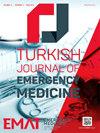急诊成人心肺复苏过程中钙的使用与结果的关系
IF 1.1
Q3 EMERGENCY MEDICINE
引用次数: 4
摘要
目的:心脏骤停期间钙的给药在某些情况下是有限的,主要是由于缺乏一致的证据。本研究旨在探讨急诊科心脏骤停期间给予钙治疗是否与良好的预后相关,包括自发循环恢复(ROSC)的概率、入院生存、出院生存以及出院时良好的神经系统预后。方法:我们回顾性分析了2016年至2018年间599例连续的成人心脏骤停事件。主要结果是ROSC率。次要结局包括住院时的生存、出院时的生存和出院时良好的神经预后。采用多变量logistic回归分析治疗权重的逆概率,以检验钙给药与预后之间的关系。结果:在599例事件中,72例(12%)给予钙。校正混杂因素后,心肺复苏(CPR)期间钙的使用与任何较好的结果无关,包括ROSC(校正优势比(aOR) 0.53, 95%可信区间[CI] 0.24-1.17)、生存至住院(aOR 1.07, 95% CI 0.47-2.41)、生存至出院(aOR 1.93, 95% CI 0.43-8.56)和良好的神经预后(aOR 6.60, 95% CI 0.72-60.74)。此外,外伤性心脏骤停患者的钙使用与不良结局相关,包括ROSC (aOR为0.02,95% CI为0.00-0.09)和住院前的生存(aOR为0.16,95% CI为0.03-0.84)。结论:在成人心脏骤停期间使用钙与更好的预后无关。虽然从本研究中得出的关联并没有表明因果关系,但在心肺复苏术中给予钙与创伤性心脏骤停患者较差的预后有关,包括ROSC和住院存活率。本文章由计算机程序翻译,如有差异,请以英文原文为准。
Association between calcium administration and outcomes during adult cardiopulmonary resuscitation at the emergency department
OBJECTIVES: Calcium administration during cardiac arrest is limited in some circumstances, mainly due to lack of consistent evidence. This study aims to investigate whether calcium therapy administered during cardiac arrest at the Emergency Department is associated with good outcomes, including the probability of return of spontaneous circulation (ROSC), survival to hospital admission, survival to hospital discharge, and favorable neurological outcome at discharge. METHODS: We retrospectively reviewed 599 consecutive adult cardiac arrest events between 2016 and 2018. The primary outcome was the ROSC rate. Secondary outcomes included survival to hospital admission, survival to hospital discharge, and favorable neurologic outcome at hospital discharge. Multivariable logistic regression with inverse probability of treatment weighting was analyzed to examine the association between calcium administration and outcomes. RESULTS: Of 599 events, calcium was administered in 72 (12%) cases. The use of calcium during cardiopulmonary resuscitation (CPR) after adjusting for confounding factors was not associated with any better outcomes, including ROSC (adjusted odds ratio (aOR) 0.53, 95% confidence interval [CI] 0.24–1.17), survival to hospital admission (aOR 1.07, 95% CI 0.47–2.41), survival to hospital discharge (aOR 1.93, 95% CI 0.43–8.56), and favorable neurological outcome (aOR 6.60, 95% CI 0.72–60.74). Besides, calcium use in traumatic cardiac arrest patients was associated with unfavorable outcomes, including ROSC (aOR 0.02, 95% CI 0.00–0.09) and survival to hospital admission (aOR 0.16, 95% CI 0.03–0.84). CONCLUSION: The use of calcium during an adult cardiac arrest was not associated with better outcomes. Although associations drawn from this study did not indicate the causality, given calcium during CPR was linked to poorer outcomes in traumatic cardiac arrest patients, including ROSC and survival to hospital admission.
求助全文
通过发布文献求助,成功后即可免费获取论文全文。
去求助
来源期刊

Turkish Journal of Emergency Medicine
EMERGENCY MEDICINE-
CiteScore
1.70
自引率
0.00%
发文量
30
审稿时长
22 weeks
期刊介绍:
The Turkish Journal of Emergency Medicine (Turk J Emerg Med) is an International, peer-reviewed, open-access journal that publishes clinical and experimental trials, case reports, invited reviews, case images, letters to the Editor, and interesting research conducted in all fields of Emergency Medicine. The Journal is the official scientific publication of the Emergency Medicine Association of Turkey (EMAT) and is printed four times a year, in January, April, July and October. The language of the journal is English. The Journal is based on independent and unbiased double-blinded peer-reviewed principles. Only unpublished papers that are not under review for publication elsewhere can be submitted. The authors are responsible for the scientific content of the material to be published. The Turkish Journal of Emergency Medicine reserves the right to request any research materials on which the paper is based. The Editorial Board of the Turkish Journal of Emergency Medicine and the Publisher adheres to the principles of the International Council of Medical Journal Editors, the World Association of Medical Editors, the Council of Science Editors, the Committee on Publication Ethics, the US National Library of Medicine, the US Office of Research Integrity, the European Association of Science Editors, and the International Society of Managing and Technical Editors.
 求助内容:
求助内容: 应助结果提醒方式:
应助结果提醒方式:


